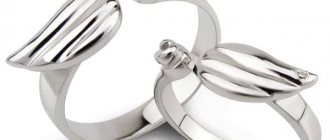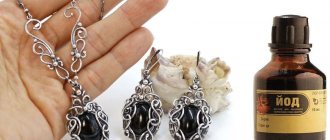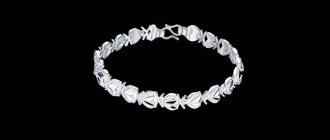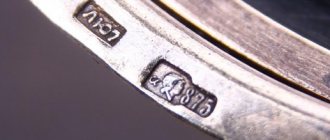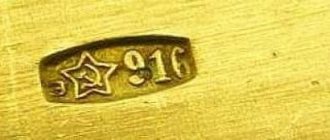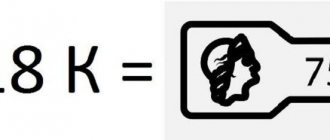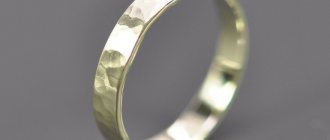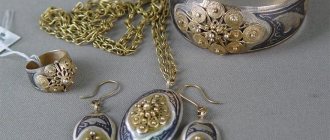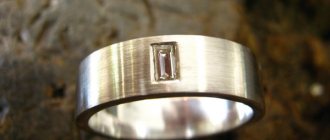Ph.D. O.V. Mosin GOLDEN WATER
Gold (lat. Aurum), Au is a chemical element of group I of the periodic system of Mendeleev with atomic number 79 and atomic mass 196.9665.
In nature, gold is a heavy yellow metal.
. Consists of only one stable isotope 197Au.
Gold was the first metal known to man. Gold products were found in cultural layers of the Neolithic era (5-4th millennium BC). In ancient states - Egypt, Mesopotamia, India, China, gold mining, the manufacture of jewelry and other items from it existed for 3-2 millennia BC. e.
Gold is often mentioned in the Bible, the Iliad, the Odyssey and other monuments of ancient literature. Alchemists called gold the “king of metals” and designated it with the symbol of the Sun. The discovery of ways to transform base metals into gold was the main goal of alchemy.
Distribution of gold in nature
The average gold content in the earth's crust is 4.3·10-7% by mass. Gold is dispersed in magma and igneous rocks, but hydrothermal gold deposits of important industrial importance (quartz gold-bearing veins, etc.) are formed from hot waters in the earth’s crust. In nature, gold is mainly found in a free (native) state and only very rarely forms minerals with selenium, tellurium, antimony, and bismuth. Pyrite and other sulfides often contain an admixture of gold, which is extracted during the processing of copper, polymetallic and other ores.
In the biosphere, gold migrates in combination with organic compounds and mechanically in river suspensions. One liter of sea and river water contains about 4·10-9 g of gold. In areas of gold deposits, groundwater contains approximately 10-6 g/l of gold. It migrates in the soil and from there gets into plants that concentrate gold - horsetails, corn. The destruction of endogenous gold deposits leads to the formation of gold placers of industrial importance. Gold is mined in 41 countries; its main reserves are concentrated in Russia, South Africa and Canada.
Alloys and samples of gold
The content of silver or gold in an alloy, that is, its purity, is called “ fineness ”.
Most countries, including Ukraine and Russia, have adopted the metric system . The number used to express the sample shows how many grams of precious metal are in 1000 grams of a product or alloy. Pure metal corresponds to the 1000th sample.
For example, 585 gold purity means that 1000 grams of the alloy contains 585 g of gold (58.5%) and 415 g of other metals (41.5%).
In the USA, Great Britain and Switzerland, the carat system . The gold purity is calculated based on 24 parts. Pure gold in the karat system is 24 carats . This figure corresponds to the 999th metric purity (the 1000th purity of gold does not exist, since it is impossible to achieve such a purity of the alloy).
18 karat hallmark means the presence of 18 parts gold in 24 parts alloy (alloy with 75% gold). 12 karat gold is 12 parts gold and 12 parts other metal to 24 parts alloy.
The higher the purity of the metal, the greater its density and, accordingly, its weight.
Fineness is not only the content of precious metal in the alloy, but also the state mark. The state hallmark is a state guarantee sign that the content of precious metals in the product is not lower than that indicated on the stamp stamp.
In the Soviet Union, GOSTs provided for 40 gold alloys of eighteen samples . Alloys of five samples were used for the production of jewelry: 375, 583, 585, 750 and 958 . The 333rd is traditionally used abroad .
999 sample
Pure gold is a relative concept; for this metal, the 999th standard is considered the standard . This alloy contains 99.9% gold, sometimes 99.99%.
The ultra-pure alloy is not used by jewelers, except in the form of inserts. 999 fineness is used exclusively for the production of coins and bank bars .
Although gold coins are no longer a means of payment, their production continues. Mints in many countries mint investment and commemorative coins from pure gold.
958 sample
958
gold alloy , in addition to gold, contains silver and copper (usually about 2%), and therefore has a bright yellow color, close to the color of pure gold.
The alloy is very soft, so scratches and chips quickly appear on products. The polish doesn't last long. Used primarily to make wedding rings, 958 is a rare alloy in the jewelry industry overall.
In stamps of three-component gold-silver-copper alloys, a digital code is used only for gold and silver. For example, the ZlSrM958-20 brand means a 958-carat gold alloy, in which, in addition to gold, there is 2% silver, the rest is copper (2.2%).
750 sample
Alloys of 750 purity (75% gold) are considered high-grade and are the most common in Europe.
For example, in Switzerland it is generally prohibited to sell products made from alloys below 750 grade. Although 750 is inferior in strength to 585, jewelers prefer it because this alloy is better processed, having excellent malleability and fluidity. Such properties allow you to create more elegant, high-quality and complex products, for example, wire weaving or a relief punch. All alloys above 750 standard do not tarnish in air.
In addition to gold (75%), the composition may include silver, copper, palladium, nickel and zinc. If jewelry made from such an alloy is decorated with colored enamel, it should contain no more than 16% copper. Its excess makes the enamel dull, in addition, such an alloy of gold darkens over time.
If 750 gold contains 10% copper and 15% silver, it acquires a light yellow tint, and if it contains 12.5% copper and 12.5% silver, it becomes bright yellow. The green color of the alloy gives 25% silver, and the red color gives 21% copper and 4% silver.
“White gold” is obtained by adding 5% silver and 20% palladium, or 7.5-16.5% nickel, 2-5% zinc and up to 15% copper to the alloy.
If a product made of 18-karat white gold is plated with rhodium, it will acquire a bluish glow and become stronger.
If jewelry made from such an alloy is decorated with colored enamel, its copper content should not exceed 16%. Its excess makes the enamel dull, in addition, such an alloy of gold darkens over time.
In two-component gold-silver alloys of 750 purity, the markings indicate the content of both gold and silver. For example, the code ZlSr750-187 reads like this: gold - 750 shares (75%) and silver - 187 shares (18.7%).
In alloys containing platinum, palladium and nickel, the digital code indicates the percentage of all components except gold. The ZlMNTs15-7.5-2.5 brand means a 750-carat gold alloy, in which copper is 15%, nickel is 7.5% and zinc is 2.5%.
585 sample
In Russia and Ukraine, the most common alloy is 585-carat gold. This is a kind of “gold standard” of the jewelry industry of post-Soviet countries.
The alloy contained 58.5% gold and various impurities, including copper, palladium, silver and nickel. The most common are three-component and more alloys.
The 585th hallmark was introduced into the USSR in 1990 to replace the 583rd hallmark , which fell just short of the world standard of 14 carats. In particular, it was used to make the Order of the Patriotic War, 1st degree , the first state award of the USSR during the Second World War, established on May 20, 1942.
585 alloys have good solderability, high strength and are widely used in the manufacture of jewelry.
If the 585 alloy contains 36% silver and 5.7% copper, then it has a green tint. With 18.3% silver and 23.4% copper - pink; at 8.3% silver and 33.4% copper - reddish.
“White gold” is obtained if you add 17% nickel, 8.9% zinc and 16% copper to 58.5% gold, or 23.7-28.7% silver and 13-18% palladium.
In gold-copper alloys, the digital code in the marking is indicated only for gold. In three-component alloys, the content of gold and silver is indicated. For example, the gold grade ZlSrM585-200 means the gold content is 58.5% (585 standard), silver - 200 shares (20%), the rest is copper.
500 sample
Products made from 500 samples consist of 50% pure precious metal.
Jewelers do not like to use this alloy because it has poor casting ability.
The shade of the alloy depends on the silver and copper content.
375 sample
Gold alloys below 375 purity (37.5% gold) are considered to be low grade. The ligature is usually silver (2-17%), copper (from 48.7%) and palladium (3.8%).
As a rule, 375 alloy is used for the manufacture of rings of simple shapes, in particular, wedding rings.
Jewelry has a muted reddish color and is especially durable. Prone to tarnishing due to high copper content.
333 sample
333-
gold (33.3%) is often called “German gold” because this hallmark is very popular in Germany.
In 1929-1948. 333 gold jewelry was widely used in the Czech Republic. Bronze was used as a ligature.
Currently, various combinations of silver (from 9.5% to 53.4%) and copper (from 13.4% to 57.2%) are used to create the alloy.
900 and 917 sample
It is worth mentioning separately the alloys of 900 and 917 samples .
They are intended not for the jewelry industry, but for numismatics. American coins from 1838 to 1933 were made from 90% gold and 10% alloyed copper, British and most European coins were made from 917 fineness.
Three-ruble, five-ruble and ten-ruble coins of the Russian Empire - from the beginning of the reign of Elizabeth (1741-1762) to the end of the reign of Alexander II (1854-1881) - were also issued from the 917 alloy.
Under Alexander III in 1885, the gold content in coins was reduced by 3.1% to 900 fineness. Gold coins of Nicholas II (1868-1918), the last Russian tsar of the Romanov dynasty, killed by the Bolsheviks, were also 900 fine. The first gold coins of the Soviet Union also preserved it.
Since the coins were not hallmarked, it is simply impossible to find the 917th hallmark. It is easier to find a Western product with a carat designation of “22K” or a foreign product with a metric mark of 916.
916 gold
22 karat gold
950 sample
950-carat gold is not used in the jewelry industry in Ukraine, Russia and other post-Soviet countries. More often you can find a product made of palladium with such a sample. In the Soviet Union, 950 standard was intended for issuing awards.
For example, the Gold Star medal , which was awarded to Heroes of the Soviet Union. The weight of the medal without the block is 21.5 grams. A total of 12,777 awards were made.
The gold medal “Hammer and Sickle” for the Hero of Socialist Labor is also made of 950 gold, weight without block - 15.25 grams. 20,605 people were awarded.
The gold alloy of this standard was also used for the Order of Lenin Type III (No. 2 695-13 378). Weighs 33.6 g, of which gold - 28.6 g. Order of Lenin Type I was made from 925-karat silver, Type II - from gold 750 (650).
The Order of Nakhimov, 1st degree, was also made of 950 gold ( II degree - from 925 silver ). The convex five-pointed ruby star weighs 57 g, of which 29.45 g is gold. The Order of Nakhimov is one of the rarest Soviet awards. A total of 551 awards were made, with 82 being awarded the Order of Nakhimov, 1st degree.
From 950 samples and the Order of Military Glory, 1st degree (II and III - silver). The total weight of the order is 30.41 g, the gold content is 28.6 g. By 1978, there were 2,562 holders of the Order of Glory, 1st degree.
In addition, in the former USSR, 950 gold was used in the 1960s and 70s for the production of single jewelry, mainly rings. It was also used in the production of leaf sheets. 950 gold alloy contains 95% gold, 3% copper and 2% silver.
Physical properties of gold
Gold is a soft, very ductile, malleable metal.
(can be forged into sheets up to 8·10-5 mm thick, stretched into wire, 2 km of which weigh 1 g), conducts heat and electricity well, and is very resistant to chemical influences. The crystal lattice of Gold is face-centered cubic, a = 4.704 Å. Atomic radius 1.44 Å, ionic radius Au1+ 1.37 Å. Density (at 20°C) 19.32 g/cm3, melting point 1064.43°C, boiling point 2947°C; thermal coefficient of linear expansion 14.2·10-6 (0-100 °C); specific thermal conductivity 311.48 W/(m K) [0.744 cal/(cm sec °C)]; specific heat capacity 132.3 J/(kg K) [0.0316 cal/(g °C)] (at 0°-100 °C); electrical resistivity 2.25·10-8 ohm·m (2.25·10-6 ohm·cm) (at 20 °C); temperature coefficient of electrical resistance 0.00396 (0-100 °C). The Brinell hardness of gold is 180 Mn/m2 (18 kgf/mm2) (for annealed gold about 400 °C).
Manufacturing process
Yellow gold jewelry is still the most popular. The process of alloying—mixing other metals with pure 24-karat gold—gives the modern material greater durability.
But impurities are added to pure gold not only for its strength. This is also done for the following reasons:
- Fluidity - for impurities the limit of this parameter is much higher.
- Color - copper or silver allows you to slightly change the shade of gold. This produces the pink and white appearance of the precious metal.
- The hardness of gold also increases noticeably with the addition of nickel or copper.
Simply put, adding impurities can significantly improve the characteristics of the metal and make it more durable and beautiful. Pure gold is too soft for everyday jewelry. With frequent wear, they quickly become deformed and lose their color. That is why the most popular is 585 gold, which has an optimal price-quality ratio.
Chemical properties of gold
Gold is the most inert metal, standing in the series of stresses to the right of all other metals; under normal conditions, it does not react with most acids and does not form oxides, which is why it was classified as a noble metal.
in contrast to ordinary metals, which are easily destroyed by the environment. Then the ability of aqua regia to dissolve gold was discovered, which shook confidence in its inertness.
Of the pure acids, gold dissolves only in hot concentrated selenic acid:
2Au + 6H2SeO4 = Au2(SeO4)3 + 3H2SeO3 + 3H2O
Gold reacts relatively easily with oxygen and other oxidizing agents with the participation of complexing agents.
Thus, in aqueous solutions of cyanides with access to oxygen, gold dissolves, forming cyanoaurates:
4Au + 8CN− + 2H2O + O2 → 4[Au(CN)2]− + 4 OH−
In the case of a reaction with chlorine, the possibility of complex formation also significantly facilitates the course of the reaction: if gold reacts with dry chlorine at ~200 °C to form gold(III) chloride, then in an aqueous solution (regia vodka) gold dissolves with the formation of chloraurate ion already at room temperature temperature:
2Au + 3Cl2 + 2Cl− → 2[AuCl4]−
Gold easily reacts with liquid bromine and its solutions in water and organic solvents, giving tribromide AuBr3.
Gold reacts with fluorine in the temperature range 300−400°C; at lower temperatures the reaction does not occur, and at higher temperatures gold fluorides decompose.
Gold also dissolves in mercury, effectively forming a low-melting alloy (amalgam).
In concentrated sulfuric acid, gold dissolves in the presence of oxidizing agents: periodic acid, nitric acid, manganese dioxide. In aqueous solutions of cyanides with access to oxygen, gold dissolves to form very strong dicyanoaurates:
4Au + 8NaCN + 2H2O + O2 → 4Na[Au(CN)2] + 4NaOH
This reaction underlies an important industrial method for extracting gold from ores.
But the most unusual properties are the properties of finely crushed gold. When gold is reduced from highly dilute solutions, it does not precipitate, but forms intensely colored colloidal solutions - hydrosols, which can be purple-red, blue, violet, brown and even black. Thus, when a reducing agent (for example, a 0.005% solution of hydrazine hydrochloride) is added to a 0.0075% solution of H[AuCl4], a transparent blue gold sol is formed, and if 0.005 is added to a 0.0025% solution of H[AuCl4] % solution of potassium carbonate, and then add tannin solution drop by drop while heating, a red transparent sol is formed. Thus, depending on the degree of dispersion, the color of gold changes from blue (coarsely dispersed sol) to red (finely dispersed sol). When the sol particle size is 40 nm, the maximum of its optical absorption occurs at 510–520 nm (red solution), and when the particle size increases to 86 nm, the maximum shifts to 620–630 nm (blue solution). The reduction reaction to form colloidal particles is used in analytical chemistry for the detection of small quantities of gold.
Organic compounds of gold are also known to science.
Thus, the action of gold(III) chloride on aromatic compounds produces compounds that are resistant to water, oxygen and acids, for example: AuCl3 + C6H6 C6H5AuCl2 + HCl. Organic derivatives of gold (I) are stable only in the presence of ligands coordinated with gold, for example, triethylphosphine: CH3Au·P(C2H5)3.
A little about the magic of gold
Gold is considered a solar metal, a very powerful and strong element. The magical properties of gold, as the metal of the Sun, affect strong people whose cosmograms have clearly expressed male signs. According to the zodiac signs, the precious metal is recommended for constant wearing for Leo, Taurus and Aries; depending on how you feel, you can wear gold jewelry for Sagittarius, Aquarius, Scorpio, Gemini; for other signs, wearing gold should be occasional.
Gold brings wealth. The magical characteristics of the metal testify to its attraction of new money, to the endowment of a person with the courage and courage that are necessary to achieve all the goals set for oneself.
A gold medallion in the shape of the sun has long been considered a talisman for those who work underground. It allows you to maintain good spirits, restore physical strength, and also protects you from collapses and other misfortunes. A medallion made of precious metal, worn in the solar plexus area, performs a protective function against any love spell.
For those who want to experience gold and its magical properties as a metal, it is necessary not only to wear precious jewelry, but also to believe in its effect. By gaining self-confidence, you will be able to realize all your goals and dreams that until recently seemed unattainable.
The very different properties of gold - physical, chemical, medicinal - determine its value in human society and the demand for the metal in the modern world. The precious metal market has been experiencing a shortage for many years: supply is much lower than demand. Gold, technical analysis of which shows a decline in sales, is constantly rising in price, but metal production continues to decline from year to year. Compensation for the shortage of metal, which, due to its characteristics, is in demand not only in the field of investment and jewelry, but is also widely used in industrial production, occurs only through smelting and reusing the yellow metal.
Getting gold
Gold can be extracted from placer deposits by flotation (precipitation), based on the large difference in densities of gold and waste rock. Gold is almost 20 times heavier than water and about 8 times heavier than sand,
Therefore, grains of gold can be separated from sand or crushed waste rock with a stream of water. The ancient method of washing using sheep skins, on which gold grains were deposited, is reflected in the ancient Greek myth of the Golden Fleece. Nuggets and placers of gold were often found along rivers, which eroded gold-bearing rocks for thousands of years. In ancient times, gold was mined only from placers. And now, where they remain, gold-bearing sand is scooped up from the bottom of rivers and lakes and enriched in dredges - huge structures the size of a multi-story building, capable of processing millions of tons of gold-bearing rock per year.
However, this method, which was already used in ancient times, is associated with great losses. It gave way to amalgamation (known already in the 1st century BC and used in America from the 16th century) and cyanidation, which became widespread in America, Africa and Australia in the 1890s.
The old (so-called mercury) method of extracting gold from ore - amalgamation is based on the fact that mercury wets gold well - like water wets glass. Finely ground gold-bearing rock was shaken in barrels with mercury at the bottom. At the same time, gold particles stuck to the liquid metal, being wetted by mercury from all sides. Because the color of the gold particles disappears, the gold may appear to have “dissolved.” The mercury was then separated from the gangue rock and heated to high temperatures. The volatile mercury was distilled off, but the gold remained unchanged. The disadvantages of this method are the high toxicity of mercury and the incomplete extraction of gold: the smallest particles are poorly wetted by mercury.
At the end of the 19th and beginning of the 20th centuries, indigenous deposits became the main source of gold. Gold-bearing rock is crushed and leached with sodium cyanide, in which even the smallest grains are converted into water-soluble cyanide compounds. Then gold is extracted from an aqueous solution using zinc powder: 2Na[Au(CN)2] + Zn → Na[Zn(CN)4] + 2Au. Leaching makes it possible to extract the remaining gold from the dumps of abandoned mines, essentially turning them into a new deposit. The method of underground leaching is also promising: a cyanide solution is pumped into wells, it penetrates through cracks into the rock, where it dissolves gold, after which the solution is pumped out through other wells.
Another method of purifying gold by electrolysis was proposed by E. Wohlwill in 1896. Anodes cast from impure gold are suspended in a bath containing a hydrochloric acid solution of AuCl3; a sheet of pure gold serves as the cathode. In this case, when a current passes, impurities precipitate (anodic sludge, sludge), and gold with a purity of at least 99.99% is deposited on the cathode.
How is it mined?
There are several methods:
- Ore. Processing gold ore is a rather labor-intensive process. This requires special equipment and permission from the state.
- Manual. The most ancient way. Using a sieve, the gold is filtered in a tray, cleaned of impurities, and then the sand is washed using a special bottle.
- Hydraulic. Potentially gold-bearing rock is eroded by special devices under a certain pressure.
Lugol's solution
In fact, iodine (common iodine I2) is insoluble in water. Let’s dissolve its complex with potassium iodide. This compound is called Lugol's solution - and it can dissolve gold. By the way, it is often used to lubricate the throat of those with a sore throat, so not everything is so simple.
This reaction also occurs through the formation of complexes. Gold forms complex anions with iodine. It is used, as a rule, for etching gold - a process in which interaction occurs only with the surface of the metal. Lugol's solution is convenient in this case because, unlike aqua regia and cyanide, the reaction is noticeably slower (and the reagents are more accessible).
Amalgam
The amalgamation process is also used in industry, only when working with ores and hard rocks. Its essence lies in the ability of mercury to form an amalgam - an intermetallic compound. Strictly speaking, mercury does not dissolve gold in this process: it remains in solid form in the amalgam.
During amalgamation, the rock is wetted with liquid mercury. However, the process of “pulling” gold into amalgam is long, dangerous (mercury vapor is poisonous) and ineffective, so this method is rarely used anywhere.
Industrial method
When extracting gold from so-called gold-bearing sands, you have to work with a suspension of approximately equally small particles of gold and grains of sand, which need to be separated from each other. You can do this by washing, or you can use sodium or potassium cyanide - there is no difference. The fact is that gold forms a soluble complex with cyanide ions, but sand does not dissolve and remains as is.
The key point in this reaction is the presence of oxygen (there is enough of it in the air): oxygen oxidizes gold in the presence of cyanide ions and a complex is obtained. If there is insufficient air or without cyanide, the reaction does not proceed.
Now this is the most common method of industrial gold production. Of course, there are still many stages before obtaining the final product, but we are specifically interested in this stage: cyanide solutions - what gold dissolves in.
